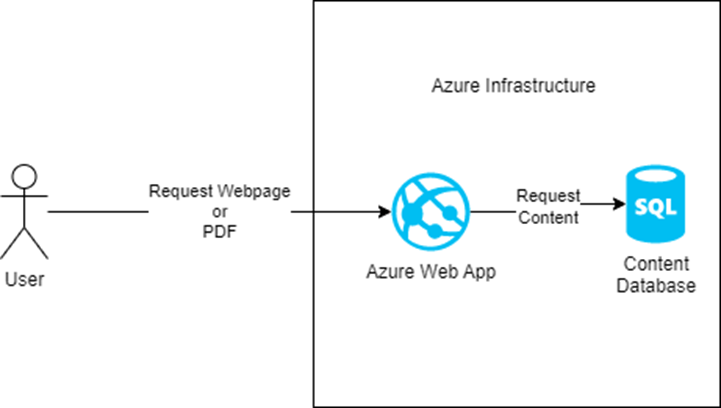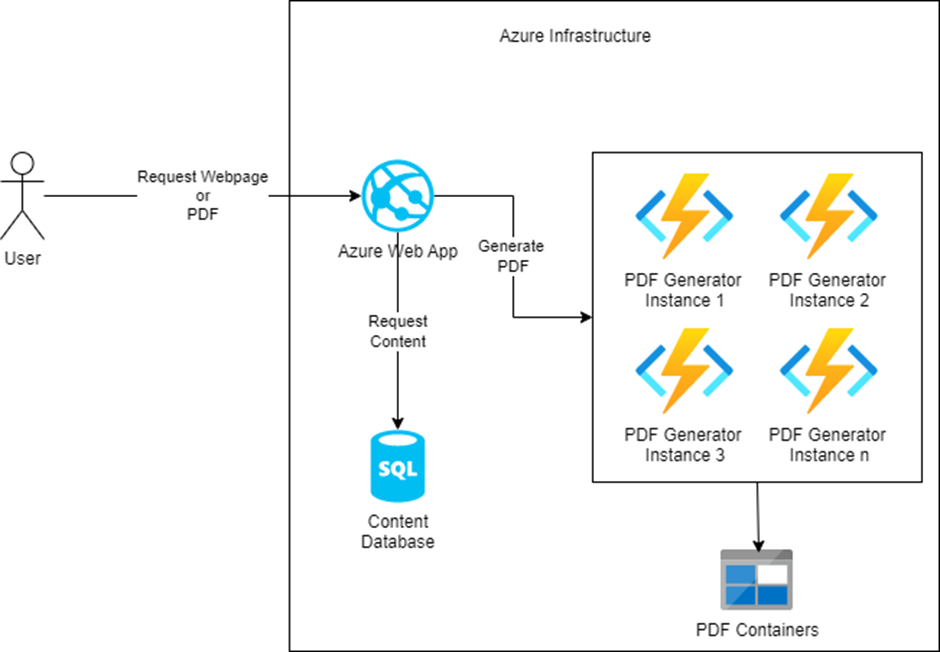Serverless computing is all the rage these days, but that doesn’t mean it’s suitable for all types of applications. It works best for stateless and small tasks that may burden your servers with a computational load.
This article explains the basics of serverless computing and the benefits and limitations of leading serverless computing solutions like Azure Functions and AWS Lambda. It also offers a case study illustrating how to use Azure Functions and AWS Lambda to build scalable applications.
What is Serverless Computing?
Serverless computing is a cloud computing paradigm that enables developers to focus solely on writing and deploying code without the need to manage or provision server infrastructure. It abstracts away the complexities of server management, and allows developers to build and run applications without worrying about scaling, capacity planning, or server maintenance.
In a serverless architecture, the cloud provider dynamically manages and allocates resources based on the application’s demand. It automatically scales up or down to accommodate traffic fluctuations. By leveraging this model, developers can achieve greater efficiency, scalability, and cost-effectiveness, as they only pay for the actual usage of resources rather than a fixed infrastructure.
It also empowers developers to concentrate on the logic and functionality of their applications, accelerating the development process and enabling rapid iteration and deployment.
Let’s discuss Azure Functions and AWS Lambda.
Azure Functions
Azure Functions is a serverless compute service provided by Microsoft Azure, designed to help developers build and deploy event-driven applications and microservices without worrying about infrastructure management. With Azure Functions, developers can focus on writing code that responds to specific events, such as HTTP requests, database updates, or message queue triggers.
Benefits of Azure Functions
- Scalability: Azure Functions automatically scale based on demand, allowing applications to handle varying workloads without manual intervention. It dynamically provisions resources to match the incoming workload, ensuring optimal performance and cost efficiency.
- Cost-effective: Since Azure Functions follows a pay-as-you-go model, users are only billed for the actual execution time of their functions. This eliminates the need for upfront infrastructure investment and allows for cost savings when applications experience idle periods.
- Integration capabilities: Azure Functions seamlessly integrates with other Azure services and third-party services, such as Azure Event Grid, Azure Storage, Azure Cosmos DB, and more. This enables developers to create powerful workflows and easily connect their functions to a wide range of data sources and services.
- Multiple programming languages: Azure Functions supports multiple programming languages, including C#, JavaScript, PowerShell, TypeScript, Node.js, Python, and more. Developers can choose the language they are most comfortable with and leverage existing code to build serverless applications.
Limitations of Azure Functions
- Execution duration limits: Azure Functions have execution duration limits; its default timeout typically ranges from 5 to 10 minutes, depending on the pricing tier. Long-running processes may require alternative solutions. If you opt for the premium plan, you can extend the default timeout to 30 minutes with a maximum memory of 3.5 GB for the consumption plan.
- Cold start latency: If a function is inactive for some time, it may experience a cold start delay when invoked. This delay occurs as Azure provisions resources to handle the request, which can impact the response time for the first invocation.
AWS Lambda
AWS Lambda is a serverless computing service offered by Amazon Web Services (AWS). It enables developers to run code without provisioning or managing servers. It also allows users to build applications using small, self-contained functions that respond to events generated by various AWS services or custom triggers.
Benefits of AWS Lambda
- Easy scalability: AWS Lambda automatically scales applications in response to incoming requests. It provisions resources to handle the workload, ensuring high availability and performance without the need for manual intervention. As with any other serverless computing solution, developers using Lambda can focus on writing code without worrying about infrastructure management.
- Broad integration: Lambda integrates seamlessly with a wide range of AWS services, including Amazon S3, DynamoDB, API Gateway, and more. This enables developers to build serverless architectures that leverage various AWS components, facilitating the creation of complex and scalable applications.
- Multiple language support: AWS Lambda supports several programming languages, including Node.js, Python, Java, C#, and Go. This flexibility allows developers to choose their preferred language and utilize existing codebases or libraries.
- Cost efficiency: Just like Azure Functions, AWS Lambda offers a pay-as-you-go pricing model, charging users based on the number of function invocations and the time taken for execution. With no upfront costs or idle time charges, developers can optimize costs by paying only for the resources consumed during actual execution.
Limitations of AWS Lambda
- Execution duration limits: AWS Lambda has maximum execution duration limits that vary depending on the chosen runtime. For example, Node.js has a maximum limit of 15 minutes. Long-running processes may require alternative cloud solutions. Moreover, AWS Lambda has a maximum payload size limit of 6 MB.
- Cold start latency: Similar to Azure Functions, AWS Lambda experiences cold start latency when a function is invoked after a period of inactivity. This delay occurs as AWS provisions resources to handle the request, which can impact the response time for the first invocation.
- Stateless nature: AWS Lambda functions are stateless by design, meaning they don’t retain any memory between invocations. If an application requires persistent state management, you should utilize external storage solutions such as databases or object stores.
It’s important to note that while Azure Functions and AWS Lambda offer similar functionalities as serverless compute services, there may be differences in terms of pricing models, integrations, and ecosystem-specific features. Developers should consider their specific requirements and evaluate both platforms to determine the best fit for their applications.
Where Should You Use Serverless Computing?
Serverless computing can be used in the following scenarios:
- To implement the backend for mobile and web applications, such as APIs.
- For real-time data processing, such as IoT device telemetry, social media feed, etc.
- For executing batch processing, e.g., data backups, report generation, etc.
- To automate business processes using event-driven programming, e.g., compressing images, uploading to S3 Bucket, etc.
- To implement a microservices architecture.
- As the backend for single-page applications.
- To generate static content pages for a CMS-based website, e.g., Next.js-based applications.
- To embed variables in the request headers and to act as a proxy service for web apps.
Scaling an App Using Azure Functions or AWS Lambda – A Case Study
Let’s take the example of a traditional web application and see how we can improve its performance by adding serverless computing solutions like AWS Lambda or Azure Functions.
Suppose a life sciences company has a reports web portal for its shareholders. It publishes its annual reports on the portal for various divisions of the company. The website has a PDF generator tool that stakeholders can use to generate customized PDF reports by selecting the relevant divisions.
Each time a stakeholder clicks on the Download PDF button to generate a PDF report, a function is triggered which generates a PDF file from the actual web pages. As we all know, generating a PDF from a web page is, computationally speaking, an expensive task. And if two users request a PDF download simultaneously, it can slow down the site or even cause the site to become unresponsive.
There are two possible solutions to overcoming this problem:
- Keep the application architecture as it is and increase server resources. This approach will cause an increase in hosting costs. Moreover, despite the server upgrade, your website performance will still be adversely impacted during the PDF generation process. This doesn’t sound like the ideal way to deal with the problem at hand.

- The other option is to move the PDF generation function to AWS Lambda or Azure Functions. Every time a PDF generation request arrives, it will trigger a Lambda or Azure function to generate the PDF. If you opt for this approach, you can easily downgrade server resources as all of its pages are static.
PDF generation Lambda will only add to your costs when a request triggers it. This is the ideal approach for ensuring optimal website performance. Given below is a sample application architecture for your reference.

Conclusion:
To conclude, serverless computing is not suitable for all types of applications, but we can leverage it to perform event-driven, stateless, and short tasks, especially tasks that add computation load to your web applications. However, by using Azure Functions or AWS Lambda, we can focus on the function itself without worrying about infrastructure management, app performance, and scaling issues.
Xavor is a proud AWS and Microsoft Azure partner with over 27 years of servicing startups and Fortune 500s with innovative tech solutions. If you need any help in developing a scalable application using Azure Functions or AWS Lambda, drop us a line at [email protected]. Our team will book you a free consultation session to discuss how we can be of help to your business.

